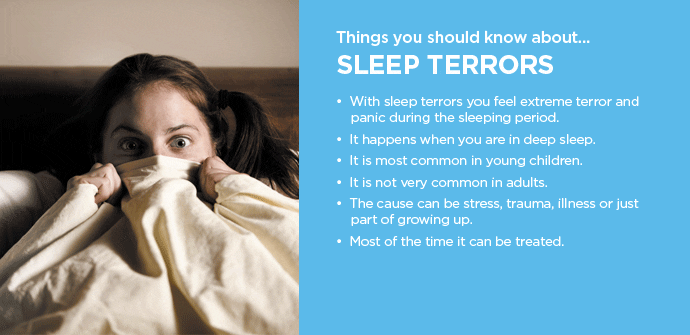Medical treatments for night terrors
– Therapeutic abstention:
Most often, night terrors manifest themselves in a benign and transient manner in genetically predisposed children. They are transient and disappear on their own, at the latest in adolescence, often more quickly.
Be careful, do not try to console the child, it is preferable not to intervene, under penalty of triggering reflexes of defense of the child. You should not try to wake him up either, as this would risk prolonging or amplifying his terror.
Parents can still act by ensuring that the child’s environment does not entail a risk of injury (nightstand with a sharp corner, wooden headboard, glass bottle next to it, etc.).
Offering the child a nap during the day (if possible) can have a beneficial effect.
It is best not to tell the child about it, just because he has no memory of it. You might as well not worry him, knowing that night terrors are part of a process of maturation of sleep. If you want to talk about it, talk about it between parents!
In the vast majority of cases, night terrors do not require any treatment or intervention. You just have to be reassured. But it’s easy to say because as parents, you can feel anxious in front of these sometimes impressive manifestations in your little child!
– Interventions in case of night terrors
In a few much rarer cases, there are a few problems, and it is only in these cases that an intervention can be considered:
– night terrors disturb the child’s sleep because they are frequent and long-lasting,
– The sleep of the whole family is disturbed,
– The child is injured or is at risk of injury because the night terrors are intense.
The intervention against night terrors is “programmed awakening”. To set it up, there is a protocol:
– Observe for 2 to 3 weeks the times when night terrors occur and carefully note them.
– Then, each night, wake up the child 15 to 30 minutes before the usual time of night terrors.
– Leave him awake for 5 minutes, then let him go back to sleep. We can take the opportunity to take it to the toilet or drink a glass of water in the kitchen.
– Continue this strategy for a month.
– Then let the child sleep without waking him up.
In general, after the month of programmed awakenings, episodes of night terror do not resume.
Note that this method is also used for cases of sleepwalking.
– Medication :
No drug has a marketing authorization for night terrors. It is strongly discouraged to use them because of their risks on the health of the children and the benignity of the problem, even when it can be impressive.
When adults continue to have night terrors, paroxetine (an antidepressant) has been suggested as a treatment.
Have also been used in the evening: melatonin (3mg) or carbamazepine (200 to 400 mg).
These two drugs should then be taken at least 30 to 45 minutes before bedtime, since night terror begins quickly after falling asleep, about 10 to 30 minutes afterwards.
Night terrors and anxiety A priori, the psychological profiles of children suffering from night terrors do not differ from those of other children. They simply present a genetic predisposition and not a manifestation of anxiety or linked to an inadequate education! However, when night terrors (or other parasomnias such as sleepwalking or bruxism) persist for years, or are daily, they may be associated with anxiety or separation anxiety or even a state of post traumatic stress disorder (linked to a past traumatic event). In this case, psychotherapy of the child may be indicated. |










